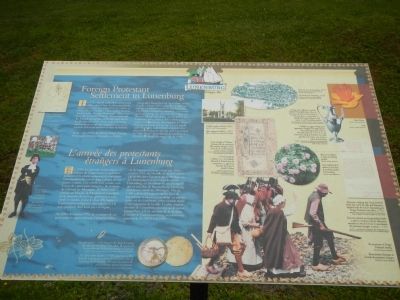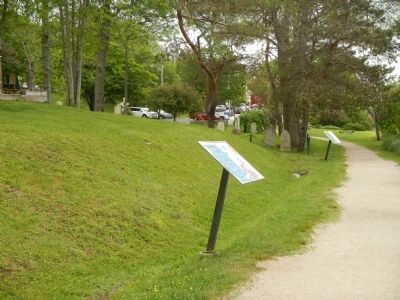Lunenburg in Lunenburg County, Nova Scotia — The Atlantic Provinces (North America)
Foreign Protestant Settlement in Lunenburg
L’arrivée des protestants étrangers à Lunenburg

Photographed By Barry Swackhamer, June 16, 2014
1. Foreign Protestant Settlement in Lunenburg Marker
Captions (English / French): (left side, top to bottom) Map of Lunenburg by Lieutenant H. Pooley, c. 1821. / Carte de Lunenburg par Le lieutenant H. Pooley, v. 1821.; Re-enactment for the 250th Anniversary. / Reconstitution historique pour le 250ᵉ anniversaire.; (bottom, center) This pocket sundial (c. 1760) belonged to Rev. Bruin R. Comingo who came with Lunenburg’s early settlers. He was the first German Reformed Presbyterian minister in the province. / Ce radian solaire de poche (v. 1760) appartenait au Rév. Bruin R. Comingo que est arrivé avec les premiers colons de Lunenburg. Il a été le premier Allemand à être ministre du culte presbytérien réformé de la province.; (right side, on left) St. John’s Anglican Church, c. 1935. / Église anglicane St. John’s , v. 1935.; A fine example of “Fraktur”, German folk art manuscript illumination, brought to Nova Scotia by the Zwicker family. / Un bel exemple de «fraktur» - art populaire allemand de l’enluminure des manuscrits - , apporté en Nouvelle-Écosse par la famille Zwicker.; (right side, on right) Bird’s eye view of Lunenburg, 1879. / Vue aérienne de Lunenburg, 1879.; Sterling silver coffee pot owned by Dettlieb Christopher Jessen. Born in Germany, he came to Nova Scotia in 1752, serving as a commissioner to distribute farming implements and rations to early Lunenburg settlers. / Cafetière en argent sterling ayant appartenu à Dettlieb Christopher Jessen. Né en Allemagne, il est arrivé en Nouvelle-Écosse en 1752 où il a été commissaire charge de distribuer des outils agricoles et des rations aux premiers colons de Lunenburg.; Globe Flower / Trolle; Roses are a tradition in many Lunenburg gardens. / Il est traditionnel de cultiver les roses dans de nombreux jardins de Lunenburg; Document certifying that Georg Frederick Bailly had sworn the oaths and declarations required under the Act for Naturalizing the Foreign Protestants and others, c. 1761. / Document attestant que Feorge Frederick Bailly a prêté les serments et fait les déclarations nécessaires in vertu de la loi sur naturalisation des protestants étrangers et autres, v. 1761.; Re-enactment of Foreign Protestant landing. / Reconstitution historique de l’arrivée des protestants étrangers.
In 1750, British authorities, mistrustful of the colony’s large Acadian population, began encouraging immigration by settlers of more obvious loyalties. These settlers became known as the “Foreign Protestants.” They came from the German Palatinate, Switzerland and the French principality of Montbéliard drawn by the promis of free land, tools and rations and a wish to escape the religious persecution, taxation and over population of their homeland.
In the early 1750’s, hundred of these Foreign Protestants were first brought to Halifax, where they languished for up to three years. Finally, in June 1753, a flotilla of ships set sail for a harbour known as Merligueche. The British renamed it Lunenburg, in honour of King George II, who was also Duke of Braunschweig-Lünenburg, a principality in Germany. More than 1,400 settlers came ashore at Lunenburg, drawing lots for their homestead grants among the Town’s rigidly laid-out streets. Lunenburg’s original street plan remains intact to this day and was central to “Old Town” Lunenburg’s designation as a UNESCO World Heritage Site in 1995.
French
En 1750, les autorités britanniques. se méfiant de l’importante population acadienne de la colonie, commencent à encourager l’immigration de colons dont l’allégeance est mieux connue. Ces colons sont connus sous le nom de «protestant étrangers». Ils viennent du Palatinat en Allemagne, de Suisse et de la principauté française de Montbéliard, tous attirés par la promesse de recevoir gratuitement terre, outils et rations, et par le désir d’échapper à la persécution religieuse, aux impôts et à la surpopulation dans leurs pays d’origine.
Au début des années 1750, des centaines de ces protestants étrangers arrivent d’abord à Halifax où ils languissent jusque’à trois ans. Enfin, en juin 1753, une flottille de navires met le cap en direction d’un port appelé Merligueche. Les Britanniques renomment l’endroit Lunenburg, en l’honneur du roi George II qui est aussi duc de Braunschweig-Lünenburg, principauté située en Allemagne. Plus de 1 400 colons débarquent sur les rives de Lunenburg et reçoivent par tirage au sort les terres où ils s’établiront, selon un plan rigide d’aménagement de la ville. Le plan original des rues de Lunenburg est toujours le même aujourd’hui et il est un coeur de la décision d’inscrire le Vieux-Lunenburg au patrimoine mondial de l’UNESCO en 1995.
Erected by Town of Lunenburg.
Topics. This historical marker is listed in this topic list: Settlements & Settlers. A significant historical month for this entry is June 1753.
Location. 44° 22.597′ N, 64° 18.866′ W.
Marker is in Lunenburg, Nova Scotia, in Lunenburg County. Marker can be reached from Linden Avenue close to Bluenose Drive. Touch for map. Marker is in this post office area: Lunenburg NS B0J, Canada. Touch for directions.
Other nearby markers. At least 8 other markers are within walking distance of this marker. The Early Acadian History of Lunenburg (a few steps from this marker); First Peoples (within shouting distance of this marker); Merligueche (within shouting distance of this marker); Lunenburg’s Fishing Industry to the 1870’s (about 150 meters away, measured in a direct line); Old Town Lunenburg Historic District (approx. 0.2 kilometers away); St. John's Anglican Church / L'église anglicane St. John's (approx. 0.2 kilometers away); Lunenburg’s Fishing Industry 1870’s - 1940’s (approx. 0.3 kilometers away); St. John's Parish Hall (approx. 0.3 kilometers away). Touch for a list and map of all markers in Lunenburg.
More about this marker. This marker is located on a path in front of the Old French Cemetery.
Additional keywords. UNESCO World Heritage Site
Credits. This page was last revised on July 24, 2018. It was originally submitted on October 25, 2014, by Barry Swackhamer of Brentwood, California. This page has been viewed 807 times since then and 16 times this year. Photos: 1, 2. submitted on October 25, 2014, by Barry Swackhamer of Brentwood, California. • Andrew Ruppenstein was the editor who published this page.
